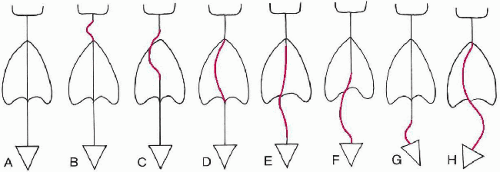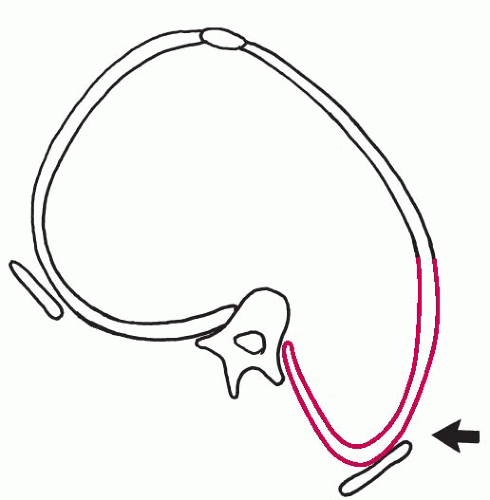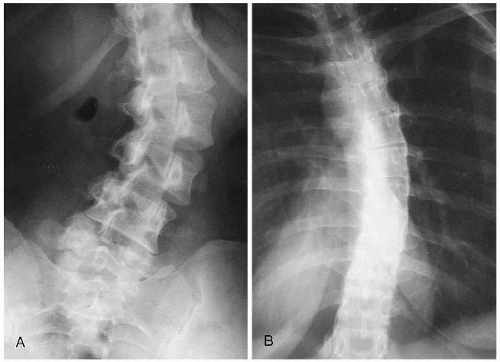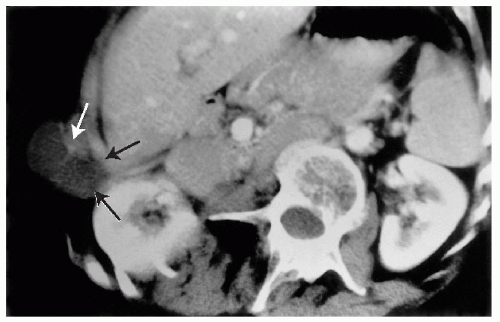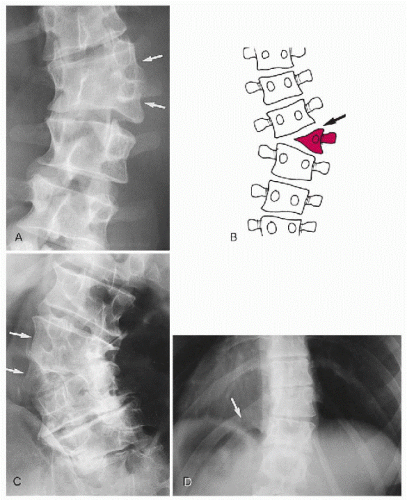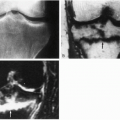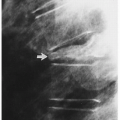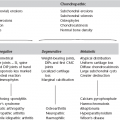Cobb’s method. Select the upper and lower end vertebrae and draw lines to represent their transverse axes (usually the superior and inferior endplates, respectively). From these lines, project intersecting perpendicular lines. The vertical (not horizontal) angle formed at this intersection represents curve magnitude. If the vertebral endplates are
poorly visualized, a line through the bottom or top of the pedicles may be used.
Risser-Ferguson method. The angle of a curve is formed by the intersection of two lines drawn from the center of the superior and inferior end vertebral bodies to the center of the apical vertebral body; less commonly used.
Table 4-1 Causal Classification of Scoliosis | ||||||||||||||||||||||||||||||||||||||||||||||||||||||||||||||||||||||||||||||||||||||||||||||||||||||||||||||||||||||||||||||||||||||||||||||||||||||||||||||||||||||||||||||||||||||||||||||||||||||||||||||||||||||||||||||||||||||||||||||||||||||||||||||||||||||||||||||||||||||||||||||||||||||||||||||||||||||||||||||||||||||||||||||||||||||||||||||||||||||||||||||||||||||||||||||||||||||||||||||||||||||||||||||||||||||||||||||||||||||||||||||||||||||||||||||||||||||||||||||||||||||||||||||||||||||||||||||||||||||||||||||||||||||||||||||||||||||||||||||||||||
|---|---|---|---|---|---|---|---|---|---|---|---|---|---|---|---|---|---|---|---|---|---|---|---|---|---|---|---|---|---|---|---|---|---|---|---|---|---|---|---|---|---|---|---|---|---|---|---|---|---|---|---|---|---|---|---|---|---|---|---|---|---|---|---|---|---|---|---|---|---|---|---|---|---|---|---|---|---|---|---|---|---|---|---|---|---|---|---|---|---|---|---|---|---|---|---|---|---|---|---|---|---|---|---|---|---|---|---|---|---|---|---|---|---|---|---|---|---|---|---|---|---|---|---|---|---|---|---|---|---|---|---|---|---|---|---|---|---|---|---|---|---|---|---|---|---|---|---|---|---|---|---|---|---|---|---|---|---|---|---|---|---|---|---|---|---|---|---|---|---|---|---|---|---|---|---|---|---|---|---|---|---|---|---|---|---|---|---|---|---|---|---|---|---|---|---|---|---|---|---|---|---|---|---|---|---|---|---|---|---|---|---|---|---|---|---|---|---|---|---|---|---|---|---|---|---|---|---|---|---|---|---|---|---|---|---|---|---|---|---|---|---|---|---|---|---|---|---|---|---|---|---|---|---|---|---|---|---|---|---|---|---|---|---|---|---|---|---|---|---|---|---|---|---|---|---|---|---|---|---|---|---|---|---|---|---|---|---|---|---|---|---|---|---|---|---|---|---|---|---|---|---|---|---|---|---|---|---|---|---|---|---|---|---|---|---|---|---|---|---|---|---|---|---|---|---|---|---|---|---|---|---|---|---|---|---|---|---|---|---|---|---|---|---|---|---|---|---|---|---|---|---|---|---|---|---|---|---|---|---|---|---|---|---|---|---|---|---|---|---|---|---|---|---|---|---|---|---|---|---|---|---|---|---|---|---|---|---|---|---|---|---|---|---|---|---|---|---|---|---|---|---|---|---|---|---|---|---|---|---|---|---|---|---|---|---|---|---|---|---|---|---|---|---|---|---|---|---|---|---|---|---|---|---|---|---|---|---|---|---|---|---|---|---|---|---|---|---|---|---|---|---|---|---|---|---|---|---|---|---|---|---|---|---|---|---|---|---|---|---|---|---|---|---|---|---|---|---|---|---|---|---|---|---|---|---|---|---|---|---|---|---|---|---|---|---|---|---|---|---|---|---|---|---|---|---|---|---|---|---|---|---|---|---|---|---|---|---|---|---|---|---|---|---|---|---|---|---|---|---|---|---|---|---|---|---|---|---|---|---|---|---|---|---|---|---|---|---|---|---|---|---|---|---|---|---|---|---|---|---|---|---|---|---|---|
| ||||||||||||||||||||||||||||||||||||||||||||||||||||||||||||||||||||||||||||||||||||||||||||||||||||||||||||||||||||||||||||||||||||||||||||||||||||||||||||||||||||||||||||||||||||||||||||||||||||||||||||||||||||||||||||||||||||||||||||||||||||||||||||||||||||||||||||||||||||||||||||||||||||||||||||||||||||||||||||||||||||||||||||||||||||||||||||||||||||||||||||||||||||||||||||||||||||||||||||||||||||||||||||||||||||||||||||||||||||||||||||||||||||||||||||||||||||||||||||||||||||||||||||||||||||||||||||||||||||||||||||||||||||||||||||||||||||||||||||||||||||
Table 4-2 Location Classification of Scoliosis | ||||||||||||||
|---|---|---|---|---|---|---|---|---|---|---|---|---|---|---|
|
which may be rapid, is between the ages of 12 and 16 years. (Fig. 4-3) Once spinal growth has ceased, as indicated by fusion of the iliac apophysis, further rapid progression is unlikely, although slow progression of idiopathic curves throughout adulthood is a recognized complication.
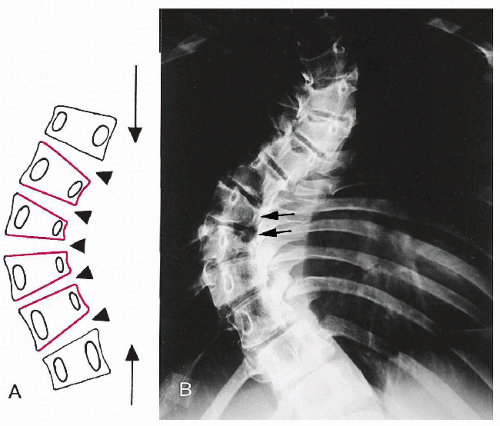 Figure 4-5 HUETER-VOLKMANN PRINCIPLE. A. AP View. Excessive compressive axial loading at the discovertebral junction (arrowheads) owing to scoliosis during the period of bone growth may produce permanent wedge-shaped vertebral bodies. B. AP Thoracic Spine. The four vertebral bodies at the apices of the curves are notably wedged. Also observe the pedicle migration of these segments, signifying vertebral rotation. (Courtesy of Leo C. Wunsch Sr, DC, DACBR, Denver, Colorado.) |
pigmentation (café-au-lait spots); and (c) neurofibromas of peripheral nerves. In addition, various skeletal lesions, including erosions, intraosseous cystic defects, deformity, pseudo-arthrosis, growth aberrations, and cranial abnormalities, may be present in up to 50% of these patients. (30)
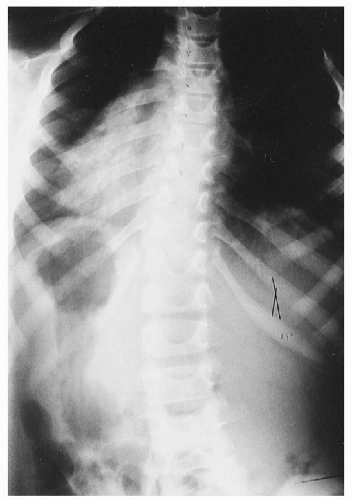 Figure 4-7 LEFT THORACIC SCOLIOSIS. AP Thoracolumbar Spine. Observe the long segment, C-shaped scoliosis convex to the left as evident by the relative positions of the heart and gastric air bubble. COMMENT: Left thoracic curves in patients under the age of 11 years may be a marker for underlying spinal canal tumors, syringomyelia, posterior fossa brain tumors, and Arnold-Chiari malformations. MRI of the entire spinal cord, including the posterior fossa, should be performed on the basis of this finding. (Courtesy of Anne P. Odenweller, DC, Baton Rouge, Louisiana.) |
cases, the scoliosis may be the result of greater slippage of the spondylolytic vertebra on one side (olisthetic scoliosis). (36) (Fig. 4-13) A more common cause of scoliosis, seen in at least 40% of spondylolisthesis cases, is muscle spasm caused by pain. (37) Scoliosis in asymptomatic spondylolisthesis occurs in 6% of cases. (37)
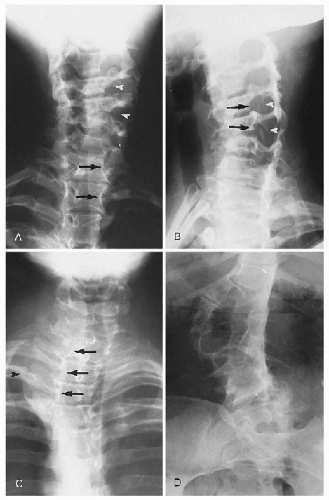 Figure 4-8 NEUROFIBROMATOSIS. A. AP Lower Cervical Spine. Observe the mild cervicothoracic scoliosis; the most dramatic changes are foraminal expansion (arrowheads) and lateral vertebral scalloping (arrows). B. Oblique Cervical Spine. Note that the foramina are greatly expanded from marked dural ectasia (arrowheads); note also the posterior scalloping of the vertebral bodies (arrows). C. AP Upper Thoracic Spine. Observe the upper thoracic curvature, lateral body scalloping (arrows), and the paraspinal mass (arrowhead) of an associated meningocele. D. AP Lumbar Spine. Observe the bizarre distortion of the lumbar bodies, posterior arches, and intervertebral foramina accompanying the scoliosis. COMMENT: Scoliosis is a common finding in neurofibromatosis and is often associated with kyphosis. (Panels A and B courtesy of William E. Litterer, DC, DACBR, Fellow, ACCR, Elizabeth, New Jersey; panel C courtesy of Clayton F. Thomsen, DC, Sydney, Australia; panel D courtesy of Lawrence A. Cooperstein, MD, Pittsburgh, Pennsylvania.)
Stay updated, free articles. Join our Telegram channel
Full access? Get Clinical Tree
 Get Clinical Tree app for offline access
Get Clinical Tree app for offline access

|
